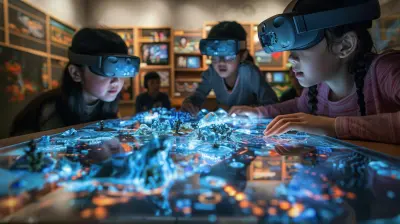How Open Educational Resources Are Shaping the Future of Learning
16 September 2025
Education is evolving fast, and it's not just about the technology we use, but also the resources we rely on. Enter Open Educational Resources (OER). You might have heard the term tossed around in academic circles or maybe even seen it in action in schools, universities, and online learning platforms. But what exactly is an OER, and why should you care?
Well, Open Educational Resources are transforming the way we learn, teach, and share knowledge. They are free, accessible, and customizable, which is already a game-changer in a world where education has been traditionally locked behind paywalls and expensive textbooks. But there's more to the story than just affordability. OERs represent a shift toward a more open, inclusive, and collaborative learning environment that benefits everyone.
In this article, we’ll dive deep into how Open Educational Resources are shaping the future of learning, why they matter, and what challenges still lie ahead. Ready to explore? Let’s dive in!

What Are Open Educational Resources (OER)?
Before we get into the nitty-gritty, let’s cover the basics. Open Educational Resources (OER) are teaching, learning, or research materials that are freely accessible and openly licensed. This means they can be used, adapted, and shared without restriction. Think of them like the "Wikipedia" of educational content. Anyone can contribute, anyone can use, and most importantly, anyone can improve.OERs come in many forms, from textbooks and lecture notes to quizzes, videos, and even full courses. The key element? They are available to the public at no cost and are designed to be modified to fit different educational contexts.
Sounds too good to be true, right? Well, it’s not. And the best part is that these resources are gaining traction globally, pushing traditional educational models to rethink their approach.

Why Are Open Educational Resources Important?
So, why should we care about OER? Let’s break it down.1. Access to Education for All
We’ve all heard the saying, "Knowledge is power." But what happens when that knowledge is locked behind a paywall? For millions of students around the world, the cost of textbooks and learning materials is a significant barrier. OERs eliminate this barrier by offering free access to high-quality content.Imagine a student in a remote village who doesn’t have access to the latest edition of an expensive biology textbook. With OER, all they need is an internet connection, and they're good to go. The democratization of knowledge is real, and OERs are at the forefront of this movement.
2. Adaptability and Flexibility
Unlike traditional textbooks, which are static and often outdated by the time they hit the shelves, OERs can be updated and adapted in real-time. Educators can tweak them to fit their curriculum, and students can use them in ways that best suit their learning styles.Let’s say you're a teacher in a country with a unique cultural context. You can take an OER on world history and modify it to include local perspectives, ensuring that the material is relevant to your students. This level of customization is nearly impossible with traditional educational resources.
3. Cost Reduction
The cost of education is skyrocketing, and textbooks are a big part of the problem. In the U.S. alone, students spend an average of $1,200 per year on textbooks. That’s a lot of money, especially when you consider that many students are already juggling tuition fees, rent, and other expenses.OERs completely eliminate this cost. By offering free alternatives to expensive textbooks, they ease the financial burden on students and make education more affordable for everyone. And it’s not just students who benefit; schools and universities can also save on the cost of providing learning materials.
4. Collaboration and Innovation
One of the coolest things about OERs is that they invite collaboration. Since they are open and free to modify, educators, students, and even organizations can collaborate to improve them. This leads to a continuous cycle of innovation.For example, a professor in the U.K. might create an OER on quantum physics, and then a teacher in India could adapt it for high school students. Over time, contributions from different educators make the resource richer and more effective. It’s like the open-source software movement, but for education!

How OERs Are Shaping the Future of Learning
Now that we’ve covered why OERs are important, let’s talk about how they are directly influencing the future of learning.1. Personalized Learning
One-size-fits-all education is becoming a thing of the past. With OERs, educators can offer personalized learning experiences that cater to individual students’ needs.Say you’re a student struggling with algebra. Instead of flipping through a generic textbook, you can access an OER that focuses specifically on the areas you’re struggling with. You can even find quizzes and exercises tailored to your learning pace. This kind of flexibility is crucial in today’s diverse educational landscape.
2. Lifelong Learning
Gone are the days when education stopped after graduation. In today’s fast-paced world, learning is a lifelong process. OERs make it easy for anyone—whether you're a high school student or a 50-year-old professional—to continue learning.Want to pick up a new skill? Understand the basics of coding? Or maybe dive into ancient history? OERs provide the resources you need, at your own pace, and at no cost. This is particularly valuable for adult learners who might not have the time or money to enroll in formal courses.
3. Global Learning Communities
With OERs, education isn’t confined to the four walls of a classroom. They enable the creation of global learning communities where students and educators from around the world can collaborate and share insights.Imagine doing a group project with students from different countries, all using the same OER. You’re not just learning the subject matter—you’re getting a global perspective, understanding different cultures, and building a network that spans borders. That’s the future of learning.
4. Sustainability and Environmental Impact
Believe it or not, OERs can also contribute to a more sustainable future. How? Well, they reduce the need for printed textbooks, which in turn reduces paper consumption. With the growing awareness around environmental issues, the shift from physical textbooks to digital OERs aligns with the global push for sustainability.Sure, digital resources have their own environmental footprint, but it’s a fraction of what’s required to produce, distribute, and dispose of physical books. The move towards OERs is not only good for your wallet but also for the planet.

The Challenges of OER
While OERs hold significant promise, they’re not without their challenges.1. Quality Control
One of the biggest concerns with OER is the issue of quality. Since anyone can create and modify OERs, there’s a risk that the content might not be accurate or up-to-date. Unlike traditional textbooks, which go through rigorous editorial processes, OERs rely on the community to ensure quality.However, platforms like MERLOT and OpenStax have put mechanisms in place to vet and review materials, ensuring that the resources meet academic standards. But it’s still something to watch out for.
2. Digital Divide
While OERs are free, they do require access to the internet and, in many cases, a computer or mobile device. For students in rural or underdeveloped areas, this can be a problem. The digital divide is real, and while OERs can help close the gap in some ways, they can also widen it if students don’t have the necessary tools to access them.3. Skepticism from Traditional Institutions
Let’s face it—change is hard. Many traditional educational institutions are still skeptical about OERs. Some educators may feel threatened by the idea of giving away their materials for free, while others might be concerned about the impact on the textbook publishing industry.But slowly, institutions are coming around, and many are even integrating OERs into their curricula. The key is to keep pushing for awareness and demonstrating the value that OERs bring to both educators and students.
The Road Ahead: What’s Next for OER?
The future of OERs looks bright, but there’s still work to be done. As the movement grows, we can expect to see more collaboration between institutions, more investment in quality control, and hopefully, a narrowing of the digital divide.Governments and educational organizations are also starting to recognize the value of OERs, with some even launching initiatives to promote their use. For instance, UNESCO has been a strong advocate for OERs, pushing for policies that support their adoption worldwide.
In a nutshell, OERs are here to stay, and they’re going to play a vital role in shaping the future of learning. The more we embrace open resources, the closer we get to a world where education is truly accessible to all.
Conclusion
Open Educational Resources are not just revolutionizing how we access knowledge; they’re reshaping the entire educational landscape. From making learning materials more affordable and accessible to fostering collaboration and innovation, OERs are paving the way for a more inclusive and flexible future of learning.Sure, there are challenges to overcome, but the potential benefits far outweigh the hurdles. As we move forward, the continued adoption and development of OERs will be crucial in creating a world where education is open, free, and available to everyone—no matter where they are.
So, what are you waiting for? Dive into the world of OER and see how it can change the way you learn, teach, or even share knowledge. The future of learning is open, and it’s just getting started.
all images in this post were generated using AI tools
Category:
Open Educational ResourcesAuthor:

Anita Harmon
Discussion
rate this article
1 comments
Azurael Shaffer
This article highlights a fascinating shift in education! The potential of Open Educational Resources (OER) to democratize learning and foster collaboration is intriguing. I'm eager to explore how these resources can enhance accessibility and innovation in diverse educational settings.
October 3, 2025 at 5:02 AM

Anita Harmon
Thank you for your insightful comment! I'm glad you found the potential of OER exciting. Their role in enhancing accessibility and fostering collaboration is indeed transformative for education.


